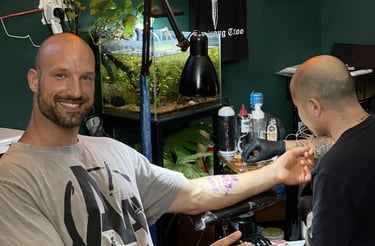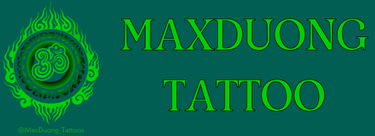Skull Tattoo Meaning – Powerful Symbol of Life and Death
Discover the deep meaning of skull tattoos at MaxDuong Tattoo Da Nang — where Japanese artistry meets life philosophy and fearless expression.
Adam D
10/26/20256 min read
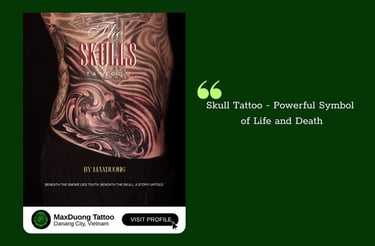

In the world of tattoo artistry, few symbols carry as much depth and paradox as the skull. Far from being merely a symbol of darkness or death, the skull tattoo represents one of humanity's most profound philosophical concepts: the duality of life and death, the celebration of existence, and the courage to face mortality with open eyes.
At MaxDuong Tattoo, a premier Japanese-style tattoo studio in Da Nang, we understand that every skull tattoo is more than an aesthetic choice—it's a personal manifesto, a visual philosophy etched into skin, and a daily reminder to live authentically and fearlessly.
The Ancient Philosophy Behind Skull Tattoos
Memento Mori – Remember You Must Die
The skull has been central to human art and philosophy for millennia. The Latin phrase "Memento Mori"—meaning "remember you must die"—encapsulates the core meaning behind skull tattoos. This isn't a morbid obsession with death, but rather a profound call to live fully.
In ancient Rome, victorious generals returning from battle would have a servant whisper "Memento Mori" during their triumphal parades. Amidst glory and celebration, this reminder kept them grounded, humble, and aware that all earthly power is temporary.
At MaxDuong Tattoo, we honor this timeless philosophy by creating skull tattoos that don't glorify death, but celebrate the courage to live authentically and embrace each moment as precious and irreplaceable.
The Skull as Life's Greatest Teacher
Because the human skull is the last part of the body to remain after death, it symbolizes:
Consciousness and intellect – the seat of our thoughts and identity
Impermanence – our temporary journey in this physical world
Transformation – the greatest change any human can experience
Wisdom – understanding that life's fleeting nature makes every moment sacred
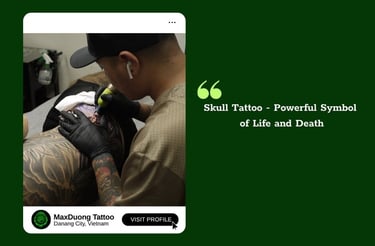

Cultural Interpretations: From East to West
Japanese Skull Tattoos (Zugaikotsu) – Embracing Change
In traditional Japanese Irezumi art, skull tattoos carry meanings distinctly different from Western interpretations. The skull, known as "Zugaikotsu," represents:
Life, Death & Transformation: Symbolizes death as a natural, positive part of life — the doorway to change and rebirth.
Honoring Ancestors: Celebrates the bond between the living and the dead, keeping ancestral wisdom alive.
Acceptance Over Fear: Teaches us to embrace death peacefully, inspiring a bold and authentic way of living.
At MaxDuong Tattoo, our Japanese-style skull tattoos often incorporate traditional elements like:
Cherry blossoms (sakura) – representing life's beautiful brevity
Waves and water – symbolizing the constant flow of existence
Chrysanthemums – the flower of death and rebirth in Japanese culture
Snakes – representing the persistence of knowledge after death
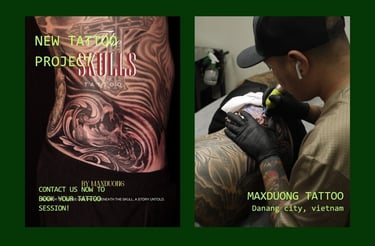

Mexican Sugar Skull (Calavera) – Celebrating Life Through Death
The Mexican Day of the Dead tradition transforms the skull from something fearful into something joyful and celebratory. Sugar skull tattoos feature:
Vibrant colors – celebrating life's beauty
Intricate floral patterns – each flower carrying personal meaning
Decorative elements – butterflies, hearts, and geometric designs
Personal symbolism – honoring deceased loved ones
These tattoos are particularly popular among women, offering a feminine, artistic approach to skull imagery while maintaining profound spiritual significance.
Celtic Skull Tattoos – The Seat of the Soul
In Celtic tradition, the skull represents "the seat of the soul"—a sacred portal connecting the physical and spiritual realms. Celtic skull tattoos often incorporate:
Knotwork patterns – representing eternal life cycles
Tribal elements – honoring warrior ancestors
Geometric precision – symbolizing cosmic order
Popular Skull Tattoo Designs At MaxDuong Tattoo
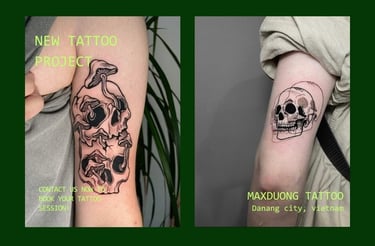

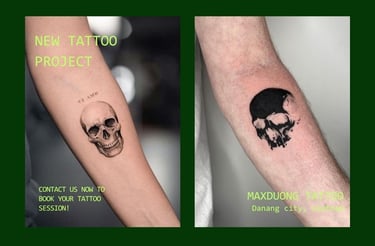

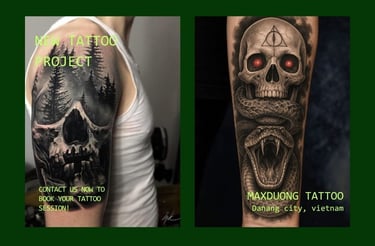

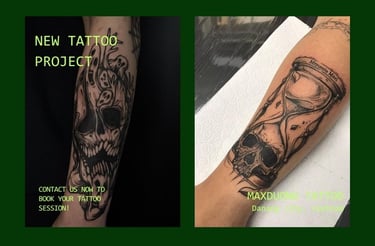

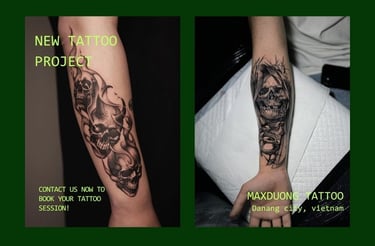

Who Should Get a Skull Tattoo?
Philosophers & Deep Thinkers: Those seeking a daily reminder of life’s impermanence and the call to live meaningfully.
Survivors & Warriors: Symbol of victory over illness, trauma, or addiction — rebirth into a new life.
Artists & Creators: See mortality as fuel for creativity, inspiring work that truly matters.
Spiritual Seekers: View death as transformation, a step toward higher understanding.
Lovers of Japanese Culture: Appreciate Irezumi’s deep symbolism beyond surface art.
Free Spirits & Rebels: Embrace life fearlessly, accepting both its beauty and its end.
Design Considerations for Your Skull Tattoo
Style Choices
Realistic Skull Tattoos: Hyper-detailed, lifelike designs symbolizing mortality and strength.
Japanese Irezumi Style: Bold hand-poked art featuring waves, flowers, and mythical motifs with traditional Nara black ink.
Neo-Traditional: Vibrant colors and bold lines blending classic and modern tattoo aesthetics.
Geometric / Abstract: Uses patterns and symmetry for a symbolic, visually striking effect.
Minimalist Line Art: Clean, fine-line designs for a subtle yet meaningful statement.
Sugar Skull (Day of the Dead): Bright, decorative tattoos celebrating life through death imagery.
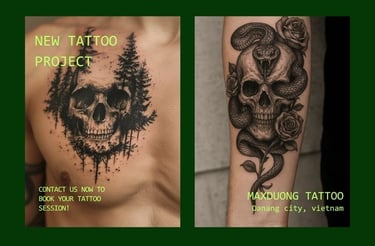

Placement and Size
Large-Scale Pieces (Back, Chest, Thigh): Allow detailed storytelling and complex compositions — bold statements of life philosophy.
Medium Pieces (Upper Arm, Forearm, Shoulder): Balance detail and practicality; visible reminders yet easy to cover when needed.
Small Pieces (Wrist, Behind Ear, Finger): Intimate and discreet — perfect for subtle, minimalist designs.
Complementary Elements
Enhance your skull tattoo's meaning by incorporating:
Flowers: Roses (love), lotus (enlightenment), chrysanthemums (death and rebirth)
Animals: Snakes (wisdom), ravens (transformation), butterflies (soul's journey)
Objects: Clocks (time), hourglasses (impermanence), candles (life's flame)
Text: Latin phrases, meaningful quotes, dates or names
Sacred geometry: Mandalas, circles (life cycles), triangles (balance)
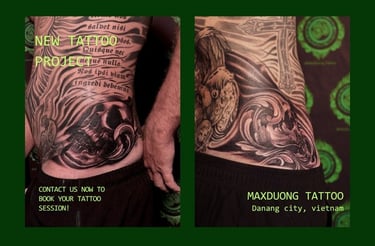

FAQ About Skull Tattoos At MaxDuong Tattoo
Are skull tattoos only for men?
Absolutely not! Skull tattoos are increasingly popular among women, especially designs that:
Incorporate feminine elements like flowers, lace, or delicate linework
Use sugar skull aesthetics with vibrant colors
Combine skulls with roses, hearts, or butterflies
Feature smaller, more delicate placements
At MaxDuong Tattoo, we specialize in customizing skull designs to match any aesthetic preference while maintaining symbolic power.
Will people think my skull tattoo means I'm obsessed with death?
Educated viewers understand skull tattoos represent life philosophy, not death obsession. They symbolize:
Living fully and authentically
Accepting mortality to enhance life quality
Philosophical depth and contemplation
Courage and fearlessness
If someone misunderstands, it's an opportunity for meaningful conversation about mortality, meaning, and memento mori philosophy.
Can I combine skull tattoos at MaxDuong Tattoo with religious symbols?
Many spiritual traditions incorporate skull imagery:
Christianity: Skulls representing eternal life, Christ's sacrifice (Golgotha means "place of the skull")
Buddhism: Skull cups (kapala) representing impermanence and transformation
Hinduism: Skulls associated with Lord Shiva, destroyer and transformer
Mexican Catholicism: Day of the Dead blending indigenous and Christian beliefs
At MaxDuong Tattoo, we work respectfully with religious symbolism, ensuring cultural sensitivity and authentic representation.
How painful is getting a skull tattoo?
Pain levels depend on:
Placement: Bony areas (ribs, spine, skull) hurt more than fleshy areas (thigh, upper arm)
Size and detail: Larger pieces require longer sessions
Individual tolerance: Everyone experiences pain differently
Tattoo technique: Hand-poked Irezumi differs from machine work
At MaxDuong Tattoo, we prioritize comfort through:
High-quality, quiet rotary machines
Numbing gel when appropriate
Regular breaks and consultation
Relaxing atmosphere with music and refreshments
How long does a skull tattoo take to heal?
Initial healing: 2-3 weeks
Week 1: Mild swelling, clear fluid, tenderness
Week 2: Peeling, itching (don't scratch!)
Week 3: New skin formation, reduced sensitivity
Complete healing: 2-3 months for full color stabilization and final appearance
Aftercare essentials:
Keep clean and moisturized
Avoid direct sunlight, swimming, soaking
Don't pick at scabs or peeling skin
Use fragrance-free, tattoo-specific products
Can skull tattoos be covered or reworked later?
Yes! Skilled artists can:
Incorporate old skull tattoos into larger designs
Cover with darker, larger pieces
Rework to update style or add elements
Laser-lighten before covering
At MaxDuong Tattoo, we specialize in both original skull designs and transforming existing work into fresh, meaningful art.
How much does a skull tattoo cost at MaxDuong Tattoo?
Pricing depends on:
Size: Small (under 5cm), medium (5-15cm), large (15cm+)
Detail level: Simple outlines vs. photorealistic shading
Color vs. black and grey
Artist experience and reputation
Session length: Complex pieces may require multiple sessions
Investment perspective: A quality skull tattoo is permanent art you'll wear forever. Choose based on artist skill and personal connection to the design, not just price.
Contact MaxDuong Tattoo for personalized consultation and accurate pricing based on your specific vision.
MaxDuong Tattoo – Tattoo Studio and Piercing in Da Nang
📞 Hotline: +84 934 823 837
📸 Instagram: @maxduong_tattoo
🌐 Website: maxduongtattoo.com
📍 Address: 205 – 207 Le Quang Dao St., Bac My An Ward, Ngu Hanh Son District, Da Nang, Vietnam
MaxDuong Tattoo – Where Philosophy Becomes Art, Where Art Becomes Life
Remember: You don't have to fear death. You just have to fear never truly living.
